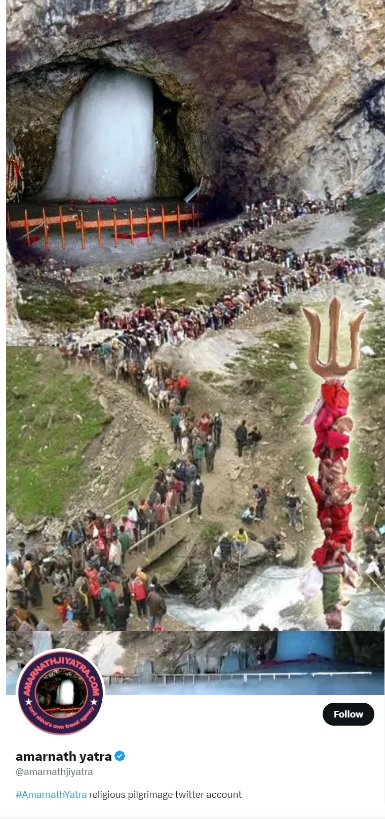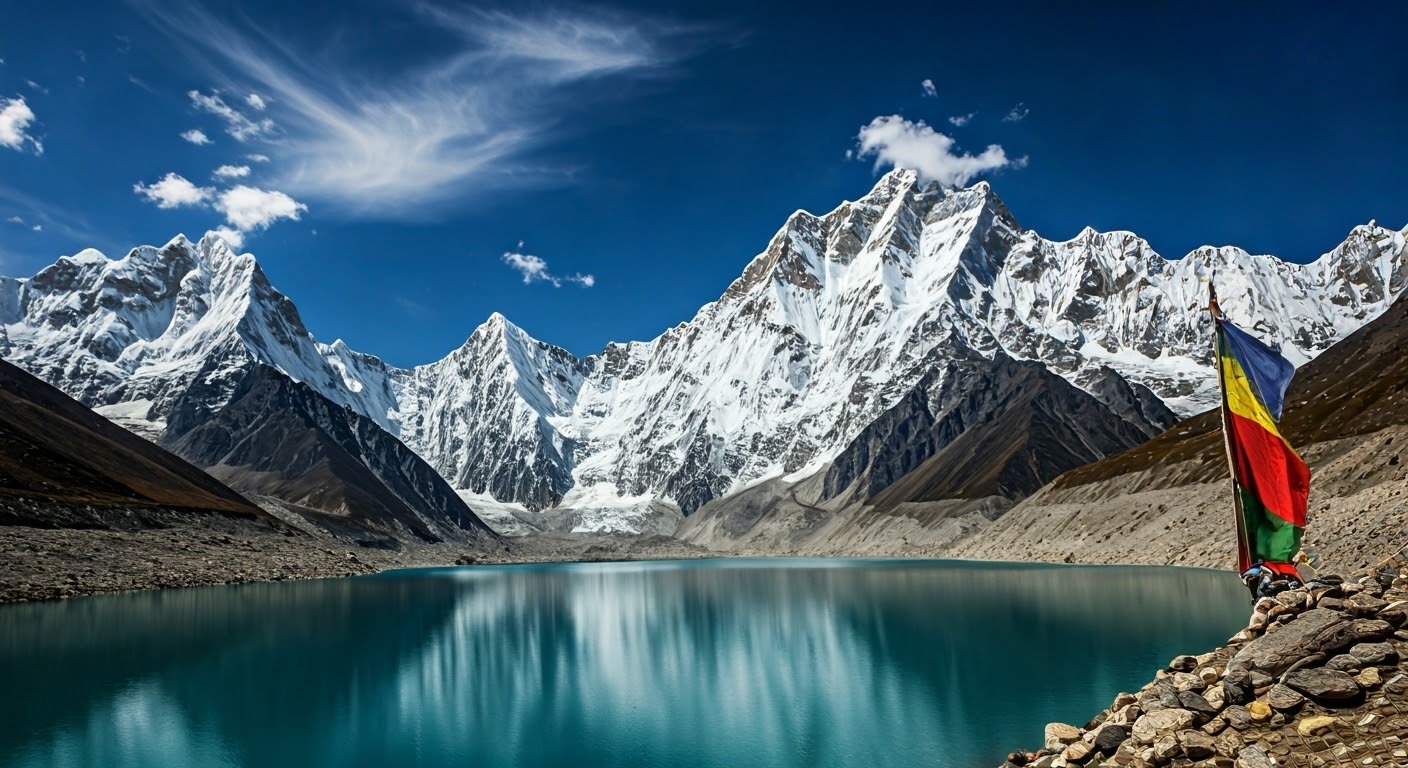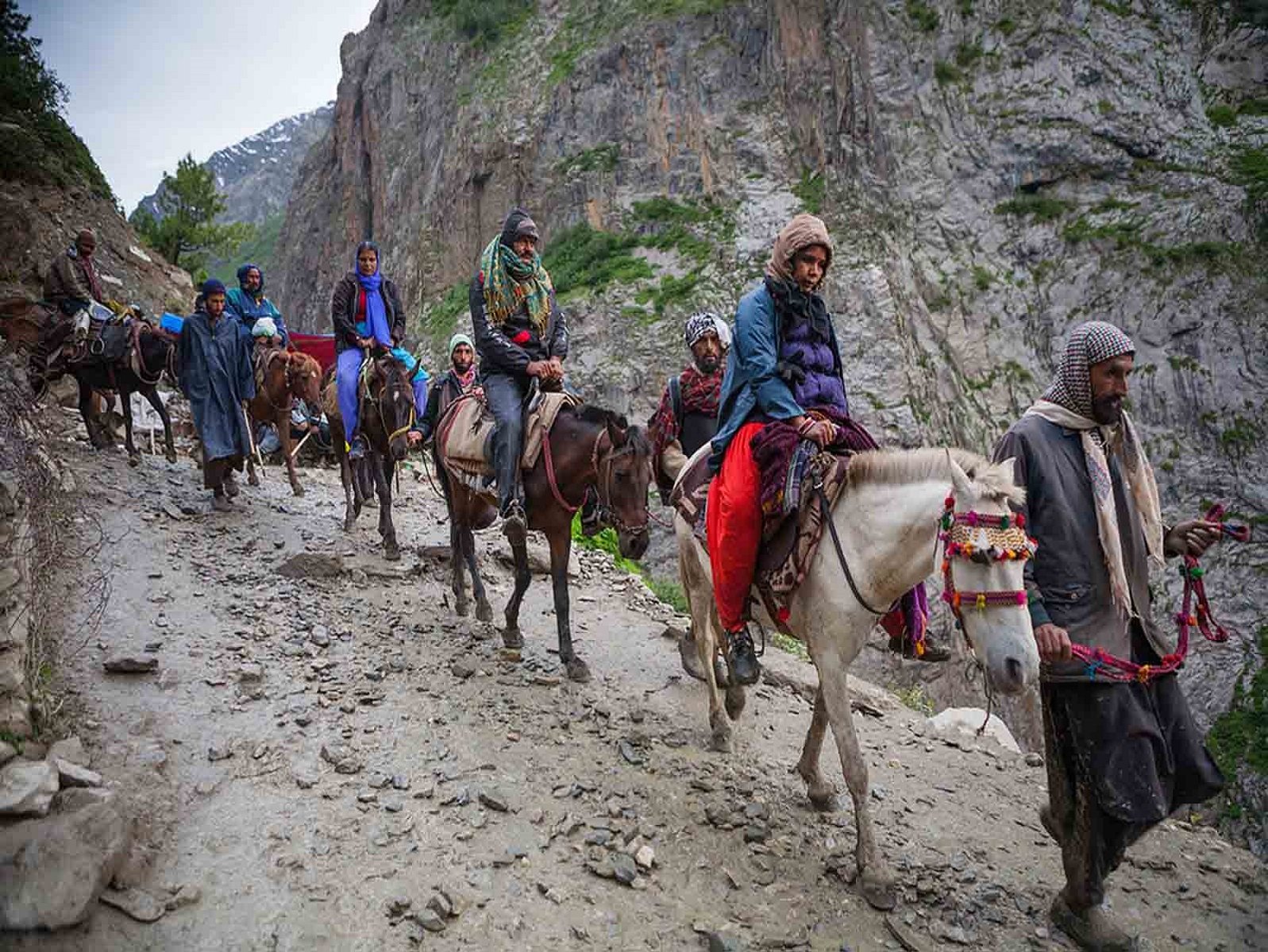Amarnath Yatra | A to Z Information | 2025 Edition
Comprehensive Handbook: Amarnath Yatra
“Your Amarnath Yatra: A 3-Part Holistic Experience.
* Before the Yatra: Expert planning, essential gear, health checks, and spiritual preparation.
* During the Yatra: Navigating the trail, experiencing the divine, enjoying local cuisine, and ensuring your safety.
* After the Yatra: Reflecting on your journey, sharing your experiences, and preserving the sacred memories.
* Ready to begin? Fill out the lead form on our website and let’s plan your unforgettable pilgrimage.”
Overview
About Amarnath Yatra 2025
1. Before the Yatra: Planning Your Journey
Proper planning is the foundation of a successful and safe pilgrimage. This section guides you through the preparation process step-by-step.
1.1 About Amarnath Yatra: Its Significance, History, and Why to Visit
Significance
The Amarnath Yatra is one of the holiest pilgrimages in Hinduism, attracting millions of devotees annually. It centers around the Amarnath Cave, which houses a naturally formed ice Lingam symbolizing Lord Shiva. According to Hindu mythology, this is the sacred spot where Lord Shiva shared the secret of immortality, known as the “Amar Katha,” with Goddess Parvati. Pilgrims believe visiting the cave and witnessing the Lingam brings blessings, peace, and spiritual enlightenment.
History
The cave’s history dates back centuries, with mentions in ancient scriptures like the Nilamata Purana. Rediscovered by a shepherd named Buta Malik in the 15th century, it has since become a prominent pilgrimage destination. Over the years, the journey has evolved into a well-organized annual event managed by the Shri Amarnathji Shrine Board (SASB), ensuring the safety and convenience of devotees.
Why Visit ?
- Spiritual Fulfillment: Pilgrims undertake the journey to seek divine blessings and deepen their connection with Lord Shiva.
- Natural Beauty: The route offers stunning views of glaciers, valleys, and snow-clad peaks.
- Cultural Immersion: Experience the warm hospitality and traditions of the Kashmiri people.
- Personal Challenge: The trek tests physical and mental endurance, rewarding participants with a profound sense of achievement.
1.2 How to Plan Your Journey
Opening Dates & Closing Dates for Amarnath Yatra 2025
- Start Date: 1st July 2025
- End Date: 9th August 2025
The Yatra aligns with the auspicious Shravan month in the Hindu calendar, a spiritually significant period. Confirm the exact dates on the official website jJksasb.nic.in
Duration
- Yatra Duration: Overall Yatra Duration 40 days.
- Trekking: 3-7 days depending on the chosen route.
- Helicopter Journey: A few hours, including darshan.
Formality and Dress Code
- Dress modestly and respectfully. Avoid wearing flashy or inappropriate clothing.
- Follow all instructions provided by the Shrine Board, including safety and environmental guidelines.
Packing Essentials
- Clothing: Thermal wear, jackets, gloves, trekking boots, and raincoats.
- Gear: Backpack, water bottles, trekking poles, torchlight, and power banks.
- First-Aid Kit: Band-aids, antiseptic cream, pain relievers, and basic medications.
- Documents: ID proof, CHC, registration slip, and travel insurance.
1.3 Routes and Transportation
Routes
-
Pahalgam Route:
- Distance: 60 km Return Journey
- Duration: 3-7 days
- Known for scenic landscapes but requires more time.
-
Baltal Route:
- Distance: 32 km Return Jouney
- Duration: 1-2 days
- Steeper and more challenging but shorter.
Transport
-
By Air:
- Srinagar Airport is the nearest major airport. From Srinagar, hire taxis or buses to Baltal (95 km) or Pahalgam (90 km).
-
By Train:
- Jammu Tawi railway station is the closest railhead. Continue the journey by road to Srinagar, Baltal, or Pahalgam.
-
By Road:
- J&K Transport Corporation buses and shared taxis connect major points like Jammu, Srinagar, Baltal, and Pahalgam.
Helicopter Services
Routes:
Srinagar- Panchtarni- Amarnath
-
Cost: ₹178250 one way.
Pahalgam-Panchtarni-Amarnath and
-
Cost: ₹4,900 one way.
Neelgrath-Baltal-Panchtarni-Amarnath.
-
Cost: ₹3,250 one way.
Booking:
Online through the official Shrine Board website helicopter.jksasb.nic.in or authorized agents.
1.4 Registration and Medical Certificate
Registration
- Registration is mandatory for all pilgrims.
Documents Required:
-
- A valid ID (Aadhaar, Passport, etc.)
- Passport-sized photographs
- CHC
Where to Register:
Online jksasb.nic.in or designated bank branches like J&K Bank, Yes Bank, Jammu & Kashmir Baank and PNB.
CHC (Compulsory Health Certificate)
- Why Needed: Ensures pilgrims are physically fit for the challenging high-altitude trek.
- Where to Obtain: From government-authorized doctors and hospitals. Download from Jksasb.nic.in
- Validity: Must be issued 30-90 days before the Yatra.
- Carry Originals: Copies are not accepted at checkpoints.
1.5 Accommodation Options
Types of Accommodation
- Base Camps: Guesthouses, lodges, and tents at Baltal and Pahalgam.
- On the Trek: Temporary tents and ashrams are set up at designated points.
Booking Tips
- Book early to secure accommodations, especially during peak season.
- Ensure bookings are made through authorized operators or platforms to avoid scams. Use amarnathyatrahuts.com for tent, hotels & hut booking
This section provides everything you need to prepare for the Yatra. The next sections will cover During the Yatra and After the Yatra in detail.
2. During the Yatra: Executing the Journey
This section focuses on the journey itself, including safety measures, facilities, and tips to make your experience as smooth as possible.
2.1 Safety, Precautions, and Tips
Safety Tips
- Follow Instructions: Adhere to the Shrine Board’s guidelines and listen to the advice of local authorities and guides.
- Stay in Groups: Trekking in groups ensures safety and provides support during the journey.
- Avoid Overexertion: Pace yourself, take breaks, and avoid rushing.
Precautions
High-Altitude Sickness:
-
- Symptoms: Headaches, nausea, dizziness, shortness of breath.
- Remedy: Rest, hydrate, and descend to a lower altitude if symptoms persist. Seek immediate medical help if severe.
Hydration:
-
- Drink at least 3-4 liters of water daily.
- Avoid caffeinated and alcoholic beverages.
Clothing:
-
- Wear layers to adjust to changing temperatures.
- Waterproof clothing is essential for sudden rains.
General Tips
Acclimatization:
Spend at least a day at base camps like Baltal or Pahalgam to adapt to the altitude.
Leave No Trace:
Carry biodegradable bags and avoid littering. Preserve the sanctity of the environment.
First-Aid Kit:
-
- Include band-aids, antiseptics, pain relievers, and altitude sickness medication.
- Carry essential medications for personal health conditions.
2.2 Trekking or Helicopter Journey
Trekking
Routes:
Pahalgam:
A longer but more scenic trek (60 km round trip).
Baltal:
A shorter, steeper trek (32 km round trip).
Tips for Trekking:
-
- Wear sturdy boots with good grip.
- Use trekking poles for support on steep sections.
- Carry light snacks like energy bars for quick boosts.
Helicopter
Routes:
Operate from Baltal and Pahalgam to Panchtarni (about 6 km from the cave).
Process:
Arrive at the helipad 1-2 hours early.
Carry original ID proof, CHC, and helicopter tickets.
Advantages:
Saves time and energy, especially for elderly or physically challenged pilgrims.
2.3 Facilities Along the Route
Food
Langars (Community Kitchens):
Free vegetarian meals are provided by volunteers at various points along the trek.
Meals typically include rice, dal, chapati, and tea.
Local Stalls:
Offer snacks, tea, and packaged food for a nominal price.
Carry cash as card payments may not be accepted in remote areas.
Water
Sources:
Clean drinking water is available at base camps and along the trek.
Refill your bottles at designated points.
Precaution:
Carry water purification tablets for emergencies.
Medical Aid
Facilities:
Medical camps are set up at key points for first aid and basic treatments.
Oxygen cylinders are available at higher altitudes.
Emergency Helpline:
Dial the Shrine Board’s helpline for immediate assistance.
Telecom Services
Network Coverage:
Limited to base camps and certain trekking points. BSNL provides the best connectivity.
Satellite Phones:
Available at specific locations for emergencies.
2.4 Photography and Videography
Guidelines
- Photography is prohibited inside the shrine and near the ice Lingam.
- Follow all signage and instructions regarding restricted areas.
Drone Usage
- Drones are not allowed unless you have prior authorization from the Shrine Board and local authorities.
Best Spots for Photography
- En route to the cave, capture the scenic views of glaciers, meadows, and valleys.
- Base camps at Pahalgam and Baltal offer great opportunities for landscape photography.
2.5 Emergency Contacts
- Medical Assistance: Toll free nos.1800-180-7198,
- Police Helpline: 112, 100
- Shrine Board Assistance: Toll free nos. 1800-180-7199
Keep these numbers accessible at all times and share them with your companions.
This section ensures you are well-prepared to tackle the challenges of the Yatra. The next section will focus on After the Yatra: Completing the Journey.
3. After the Yatra: Completing the Journey
This section highlights the steps to wrap up your pilgrimage, explore nearby attractions, and reflect on your journey.
3.1 Collecting Prasad and Making Donations
Collecting Prasad
- Prasad is available at designated counters near the shrine or at base camps.
- It includes holy offerings like dry fruits, sweets, and small replicas of the ice Lingam.
- Ensure you collect Prasad only from official counters to maintain authenticity.
Making Donations
- Donations can be made at the Shrine Board counters or online through the official website.
- Contributions are used for the upkeep of the shrine and facilities for pilgrims.
- Donation receipts are issued for your records.
3.2 Exploring Nearby Attractionss
In Srinagar:
Dal Lake:
Enjoy a relaxing Shikara ride or stay in a traditional houseboat.
Perfect for capturing serene views of the lake and surrounding mountains.
Mughal Gardens:
Visit Shalimar Bagh, Nishat Bagh, and Chashme Shahi for their manicured landscapes and historical charm.
Shankaracharya Temple:
Located atop Shankaracharya Hill, this temple offers panoramic views of Srinagar.
In Pahalgam:
Betaab Valley and Aru Valley:
Known for their lush green meadows and stunning backdrops.
Ideal for short treks and picnics.
Lidder River:
Try white-water rafting or enjoy a quiet riverside walk.
In Sonamarg:
Thajiwas Glacier:
A short trek or pony ride takes you to this beautiful glacier.
Popular for snow activities and photography.
Camping:
Experience an overnight camp under the stars surrounded by pristine nature.
3.3 Souvenirs and Shopping
In Srinagar:
Pashmina Shawls:
Authentic, high-quality shawls made from Pashmina wool.
Saffron:
Purchase the world’s finest saffron from government-approved shops.
Walnut Wood Handicrafts:
Intricately carved items like jewelry boxes, trays, and furniture.
In Pahalgam and Baltal:
Handmade Woolen Items:
Caps, sweaters, and shawls crafted by local artisans.
Dry Fruits:
Almonds, walnuts, and apricots are local specialties.
3.4 Travel Insurance and Health Monitoring
Travel Insurance
- Ensure your insurance covers the entire duration of your trip, including any unforeseen delays or medical emergencies.
- If you face health issues post-Yatra, consult a doctor immediately.
Health Monitoring
- Post-Yatra fatigue is common due to the physical exertion.
- Rest adequately, hydrate well, and monitor for signs of altitude-related illnesses or injuries.
3.5 Reflection and Sharing Your Experience
Personal Reflection
- Reflect on the spiritual and physical challenges you overcame during the Yatra.
- Many pilgrims describe a sense of inner peace and fulfillment after the journey.
Share Your Experience
- Share your Yatra stories with family and friends to inspire them.
- Post your experience on social media or travel platforms to help future pilgrims.
Follow us on Social Media Site X
3.6 Additional Information
Weather Conditions
- Post-Yatra weather may vary; check the forecast before planning additional activities.
- Carry a mix of warm and light clothing for excursions.
Environmental Concerns
- The fragile ecosystem around Amarnath requires responsible behavior.
- Avoid littering and respect the natural environment during any post-Yatra explorations.
Role of the Army and Authorities
- Acknowledge and appreciate the efforts of the Indian Army, J&K Police, and volunteers in ensuring a safe and smooth pilgrimage.
Frequently Asked Questions (FAQs)
General FAQs
- What is the best time to plan additional sightseeing?
- Immediately after the Yatra in July-August for pleasant weather.
- Are there specific souvenirs unique to Amarnath?
- Yes, look for religious items like Shiva Lingam replicas and regional handicrafts.
- Can I combine Amarnath Yatra with a full Kashmir tour?
- Absolutely. Many pilgrims extend their trip to explore Srinagar, Gulmarg, and Sonamarg.




